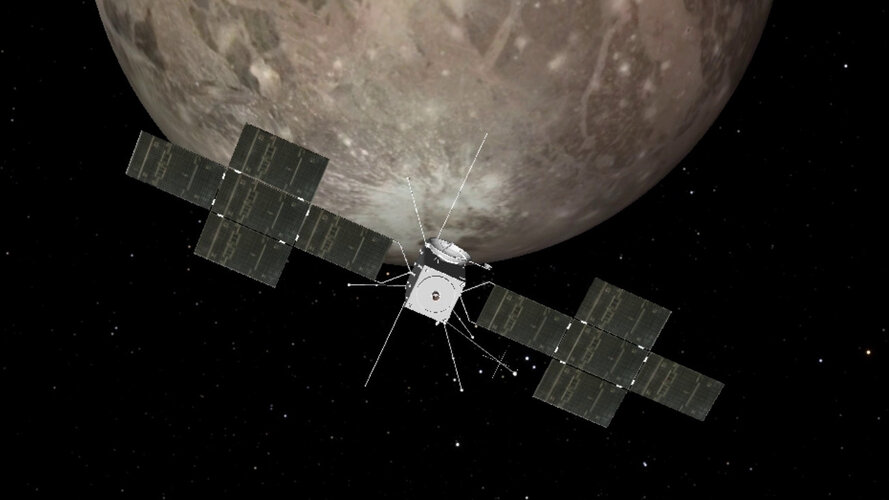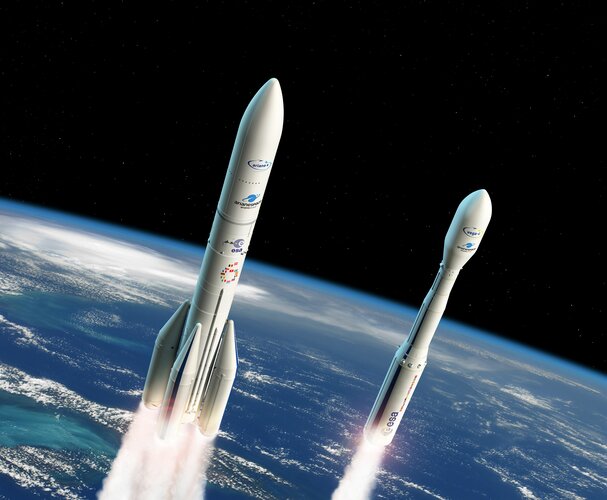
Copernical Team
'Bubble-through' nuclear engine might be a future NASA workhorse

A cutting-edge nuclear thermal propulsion (NTP) rocket engine using what's called centrifugal liquid fuel bubble-through could one day be a ticket for NASA to go directly into deep space.
Under an NTP research contract for the Space Nuclear Propulsion Project Office at NASA's Marshall Space Flight Center (MSFC), The University of Alabama in Huntsville (UAH), a part of the University of Alabama System, is leading a collaboration of universities across the nation including the University of Rhode Island (URI), Drexel University, the Massachusetts Institute of Technology (MIT), Pennsylvania State University and the University of Michigan (U-M) to research the concept.
Juice’s journey and Jupiter system tour
 Video:
00:04:25
Video:
00:04:25
ESA’s Jupiter Icy Moons Explorer, Juice, is set to embark on an eight-year cruise to Jupiter starting April 2023. The mission will investigate the emergence of habitable worlds around gas giants and the Jupiter system as an archetype for the numerous giant planets now known to orbit other stars.
This animation depicts Juice’s journey to Jupiter and highlights from its foreseen tour of the giant planet and its large ocean-bearing moons. It depicts Juice’s journey from leaving Earth’s surface in a launch window 5–25 April 2023 and performing multiple gravity assist flybys in the inner Solar System, to
ESA supports Indian lunar and solar missions
The Indian Space Research Organisation (ISRO) is launching two pioneering scientific spacecraft this year, one to study the Sun, and one to land on the Moon – the nation’s first soft landing on another celestial body.
ESA’s global deep-space communication antennas will provide essential support to both missions every step of the way, tracking the spacecraft, pinpointing their locations at crucial stages, transmitting commands and receiving ‘telemetry’ and valuable science data.
Ariane 6, Vega-C, microlaunchers: ESA looks to full range of launch options for European institutional missions

ESA Director General Josef Aschbacher today underscored the Agency’s determination to ensure that ESA’s work in space is not derailed by the tragic events in Ukraine. Mr Aschbacher stresses that work continues to assess the impact on each ongoing programme, including on missions affected by Roscosmos' withdrawal of Soyuz launch operations from Europe’s Spaceport in French Guiana.
Satellites around the Moon come another step closer

ESA is going to the Moon – in collaboration with its international partners – and seeks to build a lasting lunar link to enable sustainable space exploration.
How a major volcanic eruption paved the way for the rise of the dinosaurs
 The supercontinent Pangaea, which was a combination of today's continents, broke apart at the end of the Triassic period due to large-scale volcanic activity. This volcanic activity was thought to be the most likely cause of the fourth mass extinction, but studies were inconclusive and provided no explanation of the environmental changes that occurred at that time.
Therefore, the research
The supercontinent Pangaea, which was a combination of today's continents, broke apart at the end of the Triassic period due to large-scale volcanic activity. This volcanic activity was thought to be the most likely cause of the fourth mass extinction, but studies were inconclusive and provided no explanation of the environmental changes that occurred at that time.
Therefore, the research Sols 3425-3427: Vuggy Buggy
 I learned a new word today: vug. Vugs are small cavities or pits on a rock surface and the rock in our workspace today was noticeably "vuggy." Particularly, the triangular rock face in the bottom center portion of this Navcam image.
This vuggy rock in the "Hartle Loup" outcrop seemed particularly unique relative to the other rocks on the Greenheugh Pediment that we've seen to-date. We chos
I learned a new word today: vug. Vugs are small cavities or pits on a rock surface and the rock in our workspace today was noticeably "vuggy." Particularly, the triangular rock face in the bottom center portion of this Navcam image.
This vuggy rock in the "Hartle Loup" outcrop seemed particularly unique relative to the other rocks on the Greenheugh Pediment that we've seen to-date. We chos Sample Tally for the Crater Floor Campaign
 Perseverance has spent a little over one Earth year in Jezero crater. In the last week, the team reached a very special milestone as we officially completed our first science campaign focused on the Jezero crater floor.
During our crater floor campaign, we kept Perseverance busy! As we learned more about our surroundings, we characterized the rocks that make up the crater floor into two fo
Perseverance has spent a little over one Earth year in Jezero crater. In the last week, the team reached a very special milestone as we officially completed our first science campaign focused on the Jezero crater floor.
During our crater floor campaign, we kept Perseverance busy! As we learned more about our surroundings, we characterized the rocks that make up the crater floor into two fo Next steps for ExoMars with the rover ready
 The ESA-led Rosalind Franklin rover has a unique potential to search for evidence of past life on Mars thanks to its drill and laboratory. It will be the first rover to drill 2 m below the surface, and the first to use novel driving techniques, including wheel-walking, to overcome obstacles.
Although the 2022 launch window for the mission is no longer possible following the suspension of c
The ESA-led Rosalind Franklin rover has a unique potential to search for evidence of past life on Mars thanks to its drill and laboratory. It will be the first rover to drill 2 m below the surface, and the first to use novel driving techniques, including wheel-walking, to overcome obstacles.
Although the 2022 launch window for the mission is no longer possible following the suspension of c 

